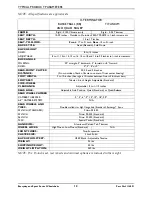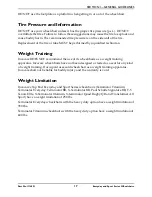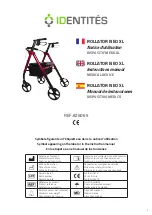
SECTION 2—SAFE HANDLING
Part No 1114851
23
Everyday and Sport Series Wheelchairs
3. The
second
assistant,
with
a
firm
hold
on
a
non
‐
detachable
part
of
the
framework,
lifts
the
wheelchair
up
and
over
the
stair
and
steadies
it
as
the
first
assistant
places
one
foot
on
the
next
stair
and
repeats
procedure.
4. The
wheelchair
should
not
be
lowered
until
the
last
stair
has
been
negotiated
and
it
has
been
rolled
away
from
the
stairway.
5. If
equipped,
turn
the
anti
‐
tippers
down.
Refer
to
Footrest/
Anti
‐
Tipper
on
page 62
in
this
manual.
WARNING
DO NOT use an escalator to move a wheelchair between floors. Serious bodily
injury may occur.
Transferring To and From Other Seats
WARNING
BEFORE attempting to transfer in or out of the wheelchair, every precaution should
be taken to reduce the gap distance. Turn both casters parallel to the object you are
transferring onto. Also be certain the wheel locks are engaged to help prevent the
wheels from moving.
When transferring, position yourself as far back as possible in the seat. This will pre-
vent damaged upholstery and the possibility of the wheelchair tipping forward.
NOTE:
This
activity
may
be
performed
independently
provided
you
have
adequate
mobility
and
upper
body
strength.
Position
the
wheelchair
as
close
as
possible
along
side
the
seat
to
which
you
are
transferring,
with
the
front
casters
parallel
to
it.
Remove
the
armrest,
if
installed.
Engage
wheel
locks.
Shift
body
weight
into
seat
with
transfer.
During
independent
transfer,
little
or
no
seat
platform
will
be
beneath
you.
Use
a
transfer
board
if
at
all
possible.










































